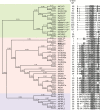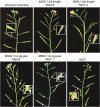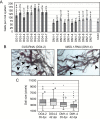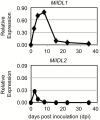The root-knot nematode Meloidogyne incognita produces a functional mimic of the Arabidopsis INFLORESCENCE DEFICIENT IN ABSCISSION signaling peptide
- PMID: 29648636
- PMCID: PMC5972575
- DOI: 10.1093/jxb/ery135
The root-knot nematode Meloidogyne incognita produces a functional mimic of the Arabidopsis INFLORESCENCE DEFICIENT IN ABSCISSION signaling peptide
Abstract
INFLORESCENCE DEFICIENT IN ABSCISSION (IDA) is a signaling peptide that regulates cell separation in Arabidopsis including floral organ abscission and lateral root emergence. IDA is highly conserved in dicotyledonous flowering plant genomes. IDA-like sequences were also found in the genomic sequences of root-knot nematodes, Meloidogyne spp., which are globally deleterious pathogens of agriculturally important plants, but the role of these genes is unknown. Exogenous treatment of the Arabidopsis ida mutant with synthetic peptide identical to the M. incognita IDA-like 1 (MiIDL1) protein sequence minus its N-terminal signal peptide recovered both the abscission and root architecture defects. Constitutive expression of the full-length MiIDL1 open reading frame in the ida mutant substantially recovered the delayed floral organ abscission phenotype whereas transformants expressing a construct missing the MiIDL1 signal peptide retained the delayed abscission phenotype. Importantly, wild-type Arabidopsis plants harboring an MiIDL1-RNAi construct and infected with nematodes had approximately 40% fewer galls per root than control plants. Thus, the MiIDL1 gene produces a functional IDA mimic that appears to play a role in successful gall development on Arabidopsis roots.
Figures






Comment in
-
Nematode-secreted peptides and host factor mimicry.J Exp Bot. 2018 May 25;69(12):2866-2868. doi: 10.1093/jxb/ery144. J Exp Bot. 2018. PMID: 29846675 Free PMC article.
Similar articles
-
A gene encoding a peptide with similarity to the plant IDA signaling peptide (AtIDA) is expressed most abundantly in the root-knot nematode (Meloidogyne incognita) soon after root infection.Exp Parasitol. 2013 Jun;134(2):165-70. doi: 10.1016/j.exppara.2013.03.019. Epub 2013 Mar 26. Exp Parasitol. 2013. PMID: 23538028
-
NEVERSHED and INFLORESCENCE DEFICIENT IN ABSCISSION are differentially required for cell expansion and cell separation during floral organ abscission in Arabidopsis thaliana.J Exp Bot. 2013 Dec;64(17):5345-57. doi: 10.1093/jxb/ert232. Epub 2013 Aug 20. J Exp Bot. 2013. PMID: 23963677
-
IDA: a peptide ligand regulating cell separation processes in Arabidopsis.J Exp Bot. 2013 Dec;64(17):5253-61. doi: 10.1093/jxb/ert338. Epub 2013 Oct 22. J Exp Bot. 2013. PMID: 24151306 Review.
-
The EPIP peptide of INFLORESCENCE DEFICIENT IN ABSCISSION is sufficient to induce abscission in arabidopsis through the receptor-like kinases HAESA and HAESA-LIKE2.Plant Cell. 2008 Jul;20(7):1805-17. doi: 10.1105/tpc.108.059139. Epub 2008 Jul 25. Plant Cell. 2008. PMID: 18660431 Free PMC article.
-
Control of Organ Abscission and Other Cell Separation Processes by Evolutionary Conserved Peptide Signaling.Plants (Basel). 2019 Jul 15;8(7):225. doi: 10.3390/plants8070225. Plants (Basel). 2019. PMID: 31311120 Free PMC article. Review.
Cited by
-
A novel sugar beet cyst nematode effector 2D01 targets the Arabidopsis HAESA receptor-like kinase.Mol Plant Pathol. 2022 Dec;23(12):1765-1782. doi: 10.1111/mpp.13263. Epub 2022 Sep 7. Mol Plant Pathol. 2022. PMID: 36069343 Free PMC article.
-
Phytoparasitic Nematode Control of Plant Hormone Pathways.Plant Physiol. 2019 Apr;179(4):1212-1226. doi: 10.1104/pp.18.01067. Epub 2018 Nov 5. Plant Physiol. 2019. PMID: 30397024 Free PMC article. Review.
-
Root-knot nematodes produce functional mimics of tyrosine-sulfated plant peptides.Proc Natl Acad Sci U S A. 2023 Jul 18;120(29):e2304612120. doi: 10.1073/pnas.2304612120. Epub 2023 Jul 10. Proc Natl Acad Sci U S A. 2023. PMID: 37428936 Free PMC article.
-
Bioinformatics and Expression Analysis of IDA-Like Genes Reveal Their Potential Functions in Flower Abscission and Stress Response in Tobacco (Nicotiana tabacum L.).Front Genet. 2021 Apr 27;12:670794. doi: 10.3389/fgene.2021.670794. eCollection 2021. Front Genet. 2021. PMID: 33986773 Free PMC article.
-
Counter-attack of biocontrol agents: Environmentally benign Approaches against Root-knot nematodes (Meloidogyne spp.) on Agricultural crops.Heliyon. 2023 Oct 28;9(11):e21653. doi: 10.1016/j.heliyon.2023.e21653. eCollection 2023 Nov. Heliyon. 2023. PMID: 37954375 Free PMC article. Review.
References
-
- Alkharouf NW, Klink VP, Chouikha IB, Beard HS, MacDonald MH, Meyer S, Knap HT, Khan R, Matthews BF. 2006. Timecourse microarray analyses reveal global changes in gene expression of susceptible Glycine max (soybean) roots during infection by Heterodera glycines (soybean cyst nematode). Planta 224, 838–852. - PubMed
-
- Barton MK. 2010. Twenty years on: the inner workings of the shoot apical meristem, a developmental dynamo. Developmental Biology 341, 95–113. - PubMed
-
- Bobay BG, DiGennaro P, Scholl E, Imin N, Djordjevic MA, Mck Bird D. 2013. Solution NMR studies of the plant peptide hormone CEP inform function. FEBS Letters 587, 3979–3985. - PubMed
-
- Branch C, Hwang CF, Navarre DA, Williamson VM. 2004. Salicylic acid is part of the Mi-1-mediated defense response to root-knot nematode in tomato. Molecular Plant-Microbe Interactions 17, 351–356. - PubMed
Publication types
MeSH terms
Substances
LinkOut - more resources
Full Text Sources
Other Literature Sources
Molecular Biology Databases
Miscellaneous

